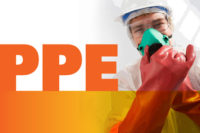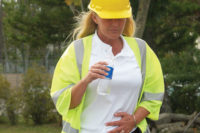Helping to fuel the concern for high fatalities, this high hazard industry is the second largest employer in the U.S. alone, needing to employ hundreds of thousands of workers in assorted trades to keep up with demand for demolition; excavations; maintenance; and new building services, such as roads, buildings, schools, airports, hospitals, power plants and housing; etc. These diverse construction activities present several hazards that can compromise the health and safety of the workers, making it imperative to understand and train on the top safety issues to keep workers safe on the job at all times.
Four lifesaving lessons
OSHA has recognized four construction hazards that are responsible for the majority of financial, physical and emotional losses in the construction industry. OSHA found that 85 percent of all citations, 90 percent of dollars applied as fines, and 79 percent of all fatalities are related to these four construction hazards. The Construction Focus Four Module (or Focus Four Hazards) was developed in support of the already existing [OSHA] Construction Outreach Program’s effort to help workers in the construction industry understand the hazards they face and know what their employer’s responsibilities are regarding protecting workers from workplace hazards. The Construction Focus Four Module is required to be included in both the 10-hour and 30-hour OSHA Construction Outreach Training Program classes, and with each focus four hazard, there is an objective for what each student should be able to do at the end of training.
OSHA’s Focus Four Hazards are:
| Fall Hazards |
| Caught-In-Between Hazards |
| Struck-By Hazards |
| Electrical Hazards |
Fall hazards that occur on a jobsite are a severe, chronic problem in the construction industry and are present at most worksites on a daily basis. A fall hazard is anything at a worksite that could cause a worker to lose their balance or lose bodily support and result in a fall; any walking or working surface can be a potential fall hazard. According to OSHA, falls from heights are the leading cause of fatalities in construction, while falls on the same level are one of the leading causes of injuries. In 2010, falls accounted for 35 percent of all construction fatalities, or about 260 deaths, according to the Bureau of Labor Statistics.
Given current OSHA and industry information regarding construction worksite illnesses, injuries and/or fatalities, workers must learn the following objectives to be able to recognize and avoid fall hazards in construction:
= Identify major fall hazards
= Describe types of fall hazards
= Protect him/herself from fall hazards
= Recognize employer requirements to protect workers from fall hazards
Hazard 2: Caught-in or -between hazards
According to OSHA, caught-in or -between hazards are defined as injuries that result from a person being squeezed, caught, crushed, pinched or compressed between two or more objects, or between parts of an object. Some working conditions that especially contribute to caught-in or -between hazards include unguarded moving machinery; equipment that is not locked-out during maintenance; unprotected excavations and trenches; heavy equipment that causes walls to collapse during demolition; and working between moving materials and immovable structures, vehicles or equipment. For example, OSHA would classify accidents like trench cave-ins, being pulled into/caught in machinery, or being compressed/crushed between rolling, sliding or shifting objects as ‘caught’.
Given current OSHA and industry information, workers must learn the following objectives to be able to recognize and avoid caught-in or -between hazards in construction:
= Identify common caught-in or -between hazards
= Describe types of caught-in or -between hazards
= Protect themselves from caught-in or -between hazards through awareness and proper engineering controls, such as fall arrest systems
= Recognize employer requirements to protect workers from caught-in or -between hazards
Struck-by injuries are produced by forcible contact or impact between the injured person and an object or piece of equipment. It is important to point out that in construction, struck-by hazards can resemble caught-in or -between hazards. The difference is that for struck-by accidents, the impact alone caused the injury, versus a caught accident where injury resulted from crushing injuries between objects. To get a better idea, struck-by hazards are categorized as a flying object, falling object, swinging object or rolling object. For example, a possible hazard could be crane collapses, falling equipment loads, faulty overhead power lines, non-visible workers, or a blast of compressed air. To protect workers from struck-by hazards, workers should use best safety practices when working around or operating heavy equipment and motor vehicles, as well as wear proper personal protective equipment.
Given current OSHA and industry information, workers must learn the following objectives to be able to recognize and avoid struck-by hazards in construction:
= Identify common struck-by hazards
= Describe types of struck-by hazards
= Protect themselves from struck-by hazards
= Recognize employer requirements to protect workers from struck-by hazards
Hazard 4: Electrocution hazards
In the U.S., electrocutions are the fourth leading cause of death among construction workers. According to OSHA, electrocution results when a person is exposed to a lethal amount of electrical energy. The top three types of electrocution hazards in construction are contact with overhead power lines, contact with energized sources, and improper use of extension and flexible cords. An electrical hazard can be defined as a workplace occurrence that exposes workers to the following dangers, as outlined by the acronym BE SAFE:
= Burns — The most common shock-related injury. Can be one of 3 types: electrical, arc/flash or thermal contact
= Electrocution — This results when a human is exposed to a lethal amount of electrical energy
= Shock — Results when the body becomes part of the electrical circuit by entering the body at one point and leaving at another
= Arc Flash/Arc Blast — This is the sudden release of electrical energy through the air when a high-voltage gap exists and there is a breakdown between conductors, giving off thermal radiation (heat) and intense light that can cause burns. Temperatures have been recorded to reach 35,000 degrees Fahrenheit
= Fire — Result from problems with ‘fixed wiring’, such as faulty electrical outlets and old wiring. Fire can also be caused by cord problems, plugs, receptacles and switches.
= Explosions — Can occur when electricity ignites an explosive mixture of material in the air
Given current OSHA and industry information, workers must learn the following objectives to be able to recognize and avoid electrocution hazards in construction:
= Identify common electrocution hazards
= Describe types of electrocution hazards
= Protect themselves from electrocution hazards
= Recognize employer requirements to protect workers from electrocution hazards
Be prepared
Utilizing the Focus Four Hazard training at a construction site is a must to ensure that proper safety precautions are taken. The problem is not that the hazards and risks are unknown, it is that they are very difficult to control in a constantly changing work environment — especially in construction. By training on the top four hazards, your workers will understand the hazards they face and know what their employer’s responsibilities are regarding protecting workers from workplace hazards, keeping them prepared for a safer work environment.
References:


